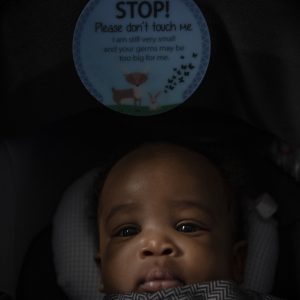‘I am a crime scene’
A woman whose uterus was removed as a minor without her consent has taken the health department to court. She is one of scores who have been forcibly sterilised in state hospitals.
Author:
29 September 2020

Bongekile Msibi was over the moon when her boyfriend proposed to her. In just a few months the two decided to have a baby. After months of trying, they consulted a doctor. Then Msibi made a heartbreaking discovery.
“[The doctor said] it is not only that I can’t conceive, I don’t have a uterus,” Msibi says, in her apartment in Boksburg, Ekurhuleni.
In her mind the doctor’s visit was supposed to be simple. “I assumed that the doctor was going to give me prescribed medication for whatever reasons that was causing me to not conceive, and that’s it. It will be life as normal.”
But the visit marked the beginning of a traumatic journey.
“It [has] brought so much sadness into my life. There is no science. There is absolutely nothing that can be done. The uterus is gone.”
No accountability
Msibi was born with a uterus. She gave birth by caesarean section to a healthy baby girl when she was 17 years old. “After I gave birth I was introduced to [the] three-month injectable contraceptive. The reason I didn’t worry [about not getting my period] is that my menstrual cycle was never regular, and I assumed it was the side effects from the contraceptive. Since 2017, I have been spotting and to this day I still spot.”
The doctor she consulted with when she was trying to conceive confirmed that her uterus was surgically removed. “The only time I was in hospital was when I gave birth. I have never been to a hospital before or after, so it made sense that when I traced my steps it was [removed] when I was giving birth,” she says.
When she received the news, Msibi was living with her fiancé. “I told him after three to four days. I remember I got back and I went straight to bed, because I was trying to comprehend [the news], and I didn’t have the strength to tell him. How do you tell someone that you have just been made aware that after so many years you don’t have a uterus?”
He was shocked, and the news took a toll on their relationship. Although her fiancé was supportive, they decided to break off the engagement and part ways because he wanted children. “I couldn’t be selfish and want to keep him yet I know I cannot give him children,” she says.
Podcast:
Msibi went back to the hospital where she gave birth to her daughter and demanded answers. She says one doctor admitted he was there when the procedure was done in 2017. He said Msibi signed a document that permitted the doctors to remove her uterus. “I said to him I don’t remember, and even if I had done that, it could’ve been unlawful because I was a minor at that time. I was 17, so it does not count,” she explains.
Subsequently, the doctor changed his story and said Msibi’s mother signed the consent forms. In a follow-up meeting with the doctor, Msibi brought her mother along. “My mother confirmed that she never signed anything. She knows absolutely nothing about a uterus being removed.”
Not having a uterus has dramatically changed Msibi’s life. “It is sad. In a way I feel that my life has been minimised. My life revolves around this one incident. When I meet a man, I have to declare that this is the situation. And that gives the next person power to either reject you or accept you as you are.”
Msibi has written to the health department to assist her in holding the health professionals who removed her uterus responsible. But she is disappointed with how the department has responded. “The department is refusing to take accountability – as if I walked in and I removed my own uterus and destroyed my own documents. I am a crime scene myself. What other proof do they need?”
A history of forced sterilisation
According to gender, health and medical historian Catherine Burns, the history of forced sterilisation of women goes back at least 200 years. “The story does not begin in South Africa at all, but what’s very interesting and painful is that it ends up in South Africa,” she said.
Forms of family planning are not a modern practice. For thousands of years human beings have been trying to control their fertility, but, all over the world, it is women who are responsible for pregnancy and fertility.
Burns says in the past governments have used eugenics to control population growth and to specifically get rid of communities they didn’t want. In Europe, Nazi Germany used this method to target the Jews, while extreme right-wing nationals in South Africa used it to prevent miscegenation.
“In South Africa the first attack is not on the so-called ‘pure Africans’. The first attack is against coloured people. In Cape Town, race welfare clinics started, trying to stop coloured people from spreading as [though they were] an infection, which [could] infect other people,” Burns explains.
“So the first line of attack is to stop poor white women from having sex with black men to make more coloured people,” she continues. She says the South African government started to target women by giving them barrier methods of birth control, including contraceptive diaphragms and intrauterine devices.
“There are some women who wanted these devices for obvious reasons. They wanted to control their fertility. Governments at that time tried to prevent women from deciding to use contraceptives. But they wanted to decide which women should get the contraceptives and which ones shouldn’t,” Burns says. “So politics was always linked to fertility control.”
Related article:
In the 1940s and 1950s, the South African government targeted what they called the “undeserving poor” for fertility control, Burns says. These people were what the apartheid government described as coloured people, rural black women and white women who fraternised with black people.
In 1966, the government’s population planning programme was mooted at cabinet level. “They decide to specifically target black women’s fertility,” she says.
It was always vulnerable women who were targeted by these vicious policies. “If taking a young women’s fertility away for a number of years was a logical and good thing for the South African government to do, and if it improved women’s health, then why [didn’t they target] white middle-class women first?” she asks.
In 2014, the KwaZulu-Natal health department said that women who received bursaries to pursue pharmacy studies in India would be injected with a contraceptive implant that would prevent them from falling pregnant. This is an act of racism and gender discrimination, Burns asserts.
The practice of forced sterilisation of women and of women being forced to take contraceptives to access certian opportunities in South Africa today is the same as what the apartheid regime did.
A shocking report
In February this year, the Commission for Gender Equality released a report that detailed the testimonies of more than 40 mostly HIV-positive black women who claimed to have been forcibly sterilised in public health facilities across the country.
The report explains that the women gave birth by caesarean section. “Just before giving birth, but either while in labour or in extreme pain, they were coerced or forced to sign forms that they later learned through various means were consent forms allegedly permitting the hospital to sterilise them,” the report says.
According to statements by the women, most were humiliated or threatened by health professionals “who told them that they would not be attended to if they did not sign the forms”.
Some of the commission’s recommendations include holding a dialogue between the health department and the complainants to find a way to rectify the wrongs. The health department should also print the consent forms in all 11 official languages and an explanation of the medical procedure should be explained in the patient’s language of choice.
Related article:
The chairperson of the commission, Tamara Mathebula, says the findings and the recommendations of the report were shared with the Department of Health, which asked the commission to provide copies of the medical records and affidavits of the complainants.
“[The commission] has advised the Department of Health that requested affidavits were confidential records and that all requested medical records were within their custody,” Mathebula says. “They have agreed to look into their own records and processes before formulating an informed response on the progress made in implementing the commission’s binding recommendations.”
A letter of demand has subsequently been issued, after the department continued to delay.
The commission also asked the South African Nurses Union and the Health Professionals Council of South Africa to implement the recommendations and hold the implicated medical professionals accountable. “We hope that with the cooperation of all parties, the matter can be resolved as soon as possible,” she concludes.
The spokesperson for the Department of Health, Popo Maja, says various provincial health departments have been asked to investigate the allegations. He adds that the health department will implement the recommendations once there’s a mutual understanding between the department and the commission.
Meanwhile, Msibi’s life is in disarray. She has taken legal action against the provincial health department for removing her uterus without her consent. The matter is currently before the court.



